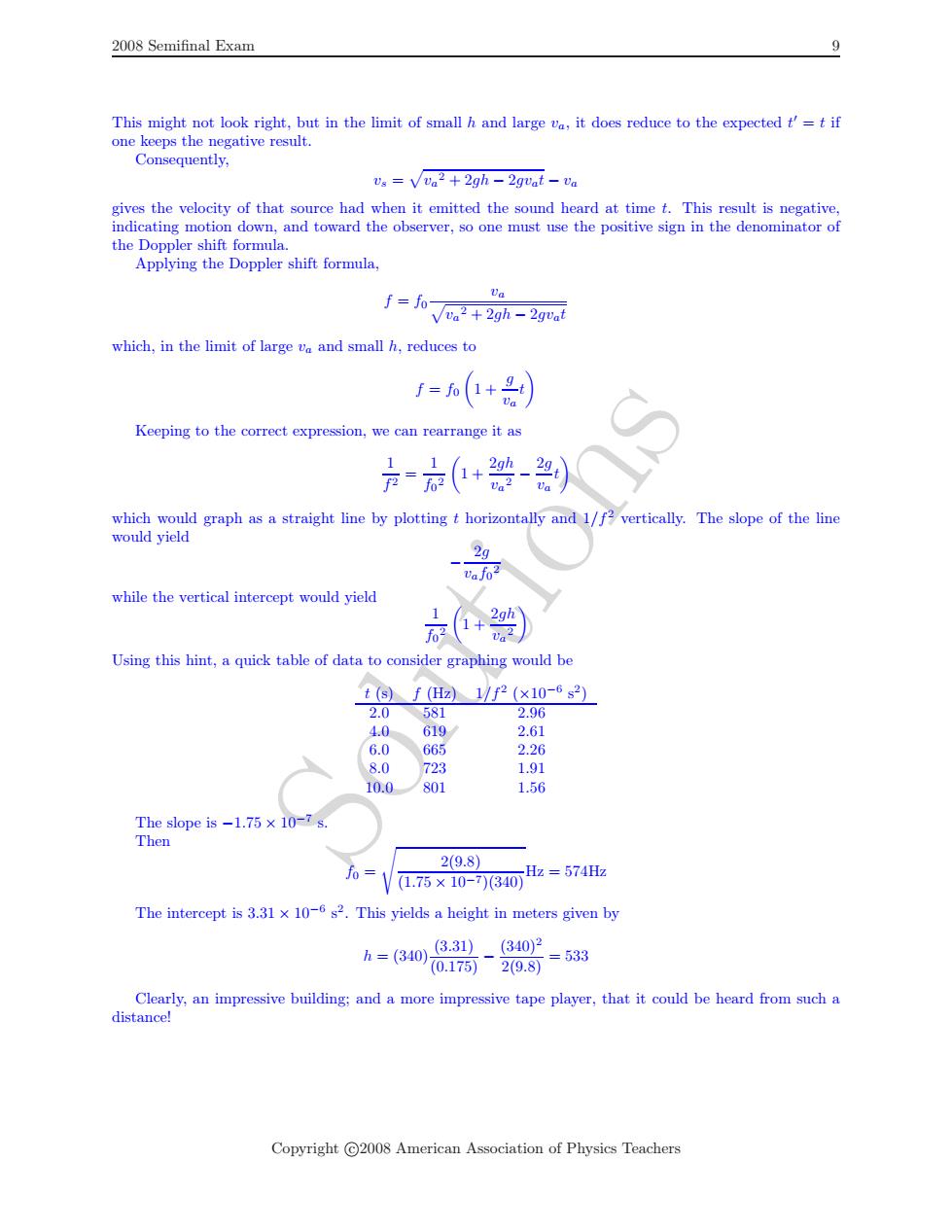正在加载图片...

2008 Semifinal Exam 9 This might not look right,but in the limit of small h and large va,it does reduce to the expected t'=t if one keeps the negative result. Consequently, Us Vva2 +2gh-2gvat-va gives the velocity of that source had when it emitted the sound heard at time t.This result is negative, indicating motion down,and toward the observer,so one must use the positive sign in the denominator of the Doppler shift formula. Applying the Doppler shift formula, f=fo- Va Vva2 +2gh-2gvat which,in the limit of large va and small h,reduces to 1=(1+是) Keeping to the correct expression,we can rearrange it as 六-(+等- 29 which would graph as a straight line by plotting t horizontally and 1/f?vertically.The slope of the line would yield 29 Vafo2 while the vertical intercept would yield 2gh fo? Using this hint,a quick table of data to consider graphing would be t(s)f(Hz)、1/f2(×10-6s2) 2.0 581 2.96 4.0 619 2.61 6.0 665 2.26 8.0 723 1.91 10.0 801 1.56 The slope is -1.75 x 10-7 s Then 2(9.8) f0= -Hz=574Hz (1.75×10-7)(340 The intercept is 3.31 x 10-6 s2.This yields a height in meters given by h=(340 (3.31)(340)2 =533 (0.1752(9.8) Clearly,an impressive building;and a more impressive tape player,that it could be heard from such a distance! Copyright C2008 American Association of Physics TeachersSolutions 2008 Semifinal Exam 9 This might not look right, but in the limit of small h and large v a, it does reduce to the expected t ′ = t if one keeps the negative result. Consequently, v s = p v a 2 + 2gh − 2gv a t − v a gives the velocity of that source had when it emitted the sound heard at time t. This result is negative, indicating motion down, and toward the observer, so one must use the positive sign in the denominator of the Doppler shift formula. Applying the Doppler shift formula, f = f0 p v a v a 2 + 2gh − 2gv a t which, in the limit of large v a and small h, reduces to f = f0 1 + gva t Keeping to the correct expression, we can rearrange it as 1f 2 = 1f02 1 + 2gh va2 − 2 g v a t which would graph as a straight line by plotting t horizontally and 1/f 2 vertically. The slope of the line would yield − 2 g v a f0 2 while the vertical intercept would yield 1f0 2 1 + 2gh va2 Using this hint, a quick table of data to consider graphing would be t (s) f (Hz) 1/f 2 (×10−6 s 2 ) 2.0 581 2.96 4.0 619 2.61 6.0 665 2.26 8.0 723 1.91 10.0 801 1.56 The slope is − 1 .75 × 10 − 7 s. Then f0 = s 2(9 .8) (1 .75 × 10 − 7)(340)Hz = 574Hz The intercept is 3 .31 × 10 − 6 s 2 . This yields a height in meters given by h = (340) (3.31) (0 .175) − (340) 2 2(9 .8) = 533 Clearly, an impressive building; and a more impressive tape player, that it could be heard from such a distance! Copyright c 2008 American Association of Physics Teachers